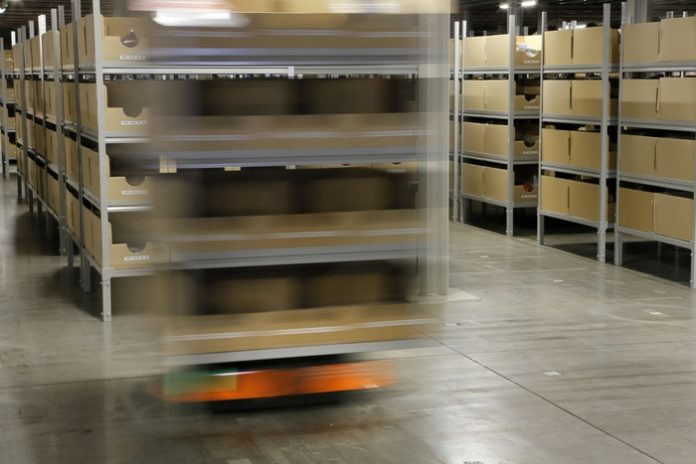2020 was a year like no other. So what are the implications for warehousing and fulfilment in 2021? Tim Wright, Managing Director of Invar Systems looks to the future of the smart warehouse. Here are five key trends:
1. The ecommerce dilemma and micro-fulfilment centres
Ecommerce has boomed during the pandemic, but what will happen when restrictions are lifted? Will shoppers return to the high street in the same numbers? Retail’s dilemma over where to invest, or how to best serve the customer whilst leveraging advantage from real estate commitments, is likely to result in the rise of micro-fulfilment centres. These will be small, highly automated facilities placed within urban areas, close to the customer, and may well be located within existing retail stores. Low-cost, scalable automation will allow the retailer to be far more responsive to customer demand, facilitating rapid 2-3hr home delivery or pick-up.
Similarly, micro-automated facilities for consolidating parcel deliveries are being planned by carriers or municipal authorities to rationalise ‘last mile’ deliveries in urban areas. These local consolidation hubs will require close collaboration between stakeholders, but would enable customers to pick-up a number of parcels ordered from different retailers using a pin-code at an ‘ATM’ style service point. Rising environmental concerns over clean air and congestion will drive a radical transformation of urban logistics.
Micro-fulfilment technology is set to accelerate in 2021 as it can be easily replicated and deployed as a network solution.
2. Agility, resilience and space
After the shocks of 2020, large retailers and manufactures will be looking to build greater resilience into their supply chains by sourcing from a broader base of suppliers, many of which may be much smaller, more local businesses. These suppliers will need to adopt systems and agile processes that allow them to perform to the exacting standards demanded by large retail clients. For many, this will mean upgrading warehouse management systems and creating agility through the use of flexible and scalable automation.
Creating resilience inevitably also means holding more stock, which translates into needing more warehousing. Pressure on available warehouse space due to Covid-19, Brexit and the inexorable rise of ecommerce will be a major issue for businesses in 2021 and beyond. A 2020 report published in the autumn by estate agents, Knight Frank, predicts that a rise of online retail sales will drive demand for 92 million sq ft of UK warehouse space by 2024. Getting the maximum use of the cube will be an imperative; so careful warehouse planning and the intelligent use of automation could provide a cost-effective solution to finding more space in an existing facility.
Businesses will need to design automation cleverly for peak, allowing for scalability, and invest in low-CapEx projects that create value immediately – as opposed to focusing on large-scale projects that deliver over a protracted period.
3. Digital transformation
A business’ competitiveness depends on its access to, and analysis of, critical data. And smart business will be developing smart warehouses where robots, pickers, packaging machines and sorters are seamlessly integrated to produce, not only optimum performance, but valuable data that is shared in real-time with wider systems in order to deliver competitive advantage.
Warehouses and fulfilment centres will become more integrated, more intelligent and more connected. Digital transformation of the warehouse will continue apace in 2021.
On the controls side, field-mounted devices are advancing rapidly, facilitating plug ‘n’ play options for rapid installation, the flexible expansion of systems or the fast replacement of components. Preventative maintenance is also taking a step forward with predictive analytics, facilitated by Profinet (Process Field Net) and BPN connections to end devices for fast collection of data and remote support.
4. Brexit reality
Brexit has become a reality. Complexity over paperwork for consignments destined for Europe has already caused many businesses considerable distress, with vehicles held up at customs points due to incomplete manifests and missing data. As a matter of urgency many organisations will need to upgrade their systems to cope, aligning warehouse management systems with new customs requirements.
The risk of delays at ports has also increased the likelihood that European businesses will hold more stock in the UK, placing higher levels of demand on UK warehousing space. Similarly, UK companies are expected to create inventory holdings on the other side of the Channel. Such moves will demand greater visibility of inventory across multiple locations, requiring intelligent warehouse management software capable of providing the complete picture.
As felt by many businesses already, Brexit has stemmed the flow of low-cost labour from Europe, impacting traditional labour-intensive warehouse activities such as order picking. Combine this with the rise of the National Living Wage to £8.72 for employees over 25 years of age and the expectation of continuing social distancing requirements extending into the foreseeable future, and there can be little surprise that businesses will be looking to introduce higher levels of automation into their warehouse processes.
Both retailers and manufacturers will be seeking operational resilience through agile automation. By adopting intelligent software and new advanced technologies, such as autonomous mobile robots (AMRs), many businesses, particularly SMEs, will move to leverage the flexibility, speed and performance of goods-to-person automation in their warehouse operations.
5. The year of the robot
This will be the year of the robot. The last 12 months has opened the eyes of omni-channel retailers to the vulnerability of highly manual processes. Their almost complete reliance on online sales during the pandemic has emphasised the critical necessity for reliable fulfilment and the efficient picking and packing of single and small multiples of order items.
Autonomous mobile robots offer the flexibility, speed and performance needed for efficient goods-to-person automation. Importantly, they offer scalability too, which is critical to allowing businesses to roll out the technology as the demands of the business dictate. AMR systems combined with pick-to-light technology can boost order picking performance from under 100 units per hour using traditional methods, to up to 600 picks per hour, with an ROI that can be as little as 12 months.

















